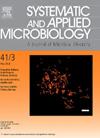Representatives of the Synergistaceae family, taxonomic description and genome sequence of Caenicola nitritireducens gen nov., sp. nov., a novel fermenting and amino-acid degrading bacterium isolated from a municipal anaerobic digester sludge
IF 4.2
2区 生物学
Q2 BIOTECHNOLOGY & APPLIED MICROBIOLOGY
引用次数: 0
Abstract
Members of the phylum Synergistota are important but understudied components of microbial communities during anaerobic digestion. In this study, their diversity was assessed in full-scale anaerobic digester sludge samples from Marrakesh wastewater treatment plant (Morocco), using 16S rRNA gene community profiling, as well as targeted isolation, physiological characterization, and genome sequencing of novel Synergistaceae isolates. The 16S rRNA gene analysis identified 23 operational taxonomic units (OTUs) belonging to the family of Synergistaceae, representing 8.8 % of the total microbial community. 17 of these OTUs belonged to previously uncultured taxa. A dominant OTU19, presumably a new representative of the family of Synergistaceae was isolated in pure culture (strain DS-S4T) and subjected to both culture- and genome-based characterizations. Phylogenetic analysis revealed that strain DZ-S4T was related to Cloacibacillus porcorum CL-84T and Cloacibacillus evryensis 158T but with low sequence similarity of 89.94 % and 88.60 %, respectively. Based on genome relatedness, including Average Nucleotide Identity (ANI) and Amino Acid Identity (AAI), strain DZ-S4T is considered to represent a novel genus for which the name Caenicola gen.nov is proposed. Moreover, several phenotypic and eco-physiological properties differentiated the novel isolate from its related species, indicating that the strain represents a new species for which the name Caenicola nitritireducens sp. nov. is proposed, with strain DZ-S4T (=DSM 104940T = JCM 31897T) being the type strain. Additionally, this study investigates the ecological role of strain DZ-S4T, specifically the protein degradation, the bioconversion of carbohydrates, and the nitrite reduction during anaerobic digestion.
从城市厌氧消化池污泥中分离的一种新型发酵和氨基酸降解细菌——硝酸还原Caenicola nitnittireducens gen nov., sp. nov.的分类描述和基因组序列
在厌氧消化过程中,协同菌门的成员是微生物群落的重要组成部分,但研究不足。在这项研究中,利用16S rRNA基因群落分析、靶向分离、生理表征和新型协同菌科分离物的基因组测序,在摩洛哥马拉喀什污水处理厂的全规模厌氧消化污泥样本中评估了它们的多样性。16S rRNA基因分析鉴定出23个操作分类单位(otu),属于协同菌科,占总微生物群落的8.8%。这些otu中有17个属于以前未培养的分类群。从纯培养菌株DS-S4T中分离出一株优势OTU19,并进行了基于培养和基因组的鉴定。系统发育分析表明,菌株DZ-S4T与腐臭Cloacibacillus porcorum CL-84T和evycloacibacillus 158T亲缘关系较近,序列相似性较低,分别为89.94%和88.60%。基于基因组亲缘性,包括平均核苷酸同源性(ANI)和氨基酸同源性(AAI),菌株DZ-S4T被认为是一个新属,并被命名为Caenicola gen.nov。此外,该菌株的表型和生态生理特征与近缘种有明显的差异,表明该菌株代表了一个新种,并被命名为Caenicola nitritireducens sp. 11 .,菌株DZ-S4T (=DSM 104940T = JCM 31897T)为型菌株。此外,本研究还研究了菌株DZ-S4T在厌氧消化过程中的生态作用,特别是蛋白质降解、碳水化合物的生物转化和亚硝酸盐的还原。
本文章由计算机程序翻译,如有差异,请以英文原文为准。
求助全文
约1分钟内获得全文
求助全文
来源期刊

Systematic and applied microbiology
生物-生物工程与应用微生物
CiteScore
7.50
自引率
5.90%
发文量
57
审稿时长
22 days
期刊介绍:
Systematic and Applied Microbiology deals with various aspects of microbial diversity and systematics of prokaryotes. It focuses on Bacteria and Archaea; eukaryotic microorganisms will only be considered in rare cases. The journal perceives a broad understanding of microbial diversity and encourages the submission of manuscripts from the following branches of microbiology:
 求助内容:
求助内容: 应助结果提醒方式:
应助结果提醒方式:


